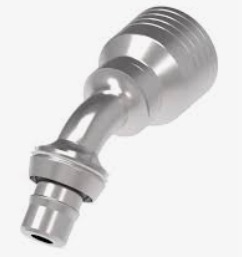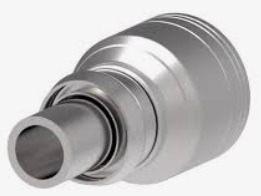Hydraulic systems are the unseen force behind numerous machines and industrial processes. They operate in everything from elevators to aircraft, providing efficient power transmission using fluid pressure.
Within these hydraulic systems, the role of fittings cannot be understated. They are the connectors that ensure the seamless flow of fluids under high pressure. STC Hydraulic Fittings, in particular, have set a new standard for precision in fluid conveyance.
What are STC fittings?
STC Male 45-Degree Elbow Hydraulic Hose End STC Male Straight Hydraulic Hose End
The term “STC” typically refers to a Snap-to-Connect fitting used in hydraulic systems, particularly in the context of high-pressure oil delivery in diesel engines.
STC Hydraulic Fittings represent the epitome of precision in fluid conveyance. Crafted with meticulous engineering, these fittings play a pivotal role in facilitating the seamless flow of fluids in various industries.
Significance of Precision in Fluid Conveyance
Precision is not just a quality but a necessity in the realm of fluid conveyance. In this article, we unravel the world of STC Hydraulic Fittings, delving into the art of precision engineering that defines these components and exploring their profound impact on fluid systems.
The Art of Precision Engineering
➡️ Crafting STC Hydraulic Fittings
STC Hydraulic Fittings are the result of a symphony of precision engineering. Every contour, thread, and connection point is meticulously crafted to ensure optimal performance. The attention to detail in the manufacturing process sets STC fittings apart, contributing to their reliability in critical fluid applications.
➡️ Tolerance and Exactitude in Design
Precision engineering is not just about meeting tolerances; it’s about surpassing them with exactitude. STC Hydraulic Fittings embody this philosophy, where each component is designed and manufactured to operate within the narrowest margins, ensuring a level of precision that is synonymous with excellence.
Materials Mastery
➡️ High-Grade Materials for STC Fittings
The choice of materials is a critical aspect of STC Hydraulic Fittings. These fittings are crafted from high-grade materials, carefully selected to withstand the rigors of fluid conveyance. From corrosion-resistant alloys to robust stainless steel, the material mastery in STC fittings ensures durability and longevity.
➡️ Impact of Material Choice on Precision
Precision is not only about design; it’s about material resilience. The materials chosen for STC Hydraulic Fittings not only contribute to their longevity but also play a pivotal role in maintaining precision over time. The impact of material choice resonates through the veins of these fittings, ensuring they stand the test of time.
Innovative Thread Design
➡️ STC Thread Technology
Threads are the unsung heroes of hydraulic fittings, and STC takes thread design to a new echelon. The threading technology employed in STC Hydraulic Fittings is a testament to innovation. The threads are not just functional; they are a work of engineering art, providing secure connections and minimizing the risk of leaks.
➡️ Importance of Thread Consistency
Consistency in thread design is paramount for precision in fluid conveyance. STC understands this importance and ensures that each fitting maintains a consistent thread pattern. This uniformity not only eases installation but also enhances the overall reliability of hydraulic systems.
Sealing Mechanisms: O-Rings and Seals
➡️ The Role of O-rings in STC Fittings
O-rings are the guardians of precision in hydraulic connections. STC Hydraulic Fittings incorporate O-rings with a purpose – to create a perfect seal. The strategic placement and quality of these O-rings ensure that STC fittings not only connect components but do so with an airtight precision that prevents leaks.
➡️ Achieving Impeccable Sealing Precision
Precision in fluid conveyance is futile without impeccable sealing. STC Hydraulic Fittings achieve sealing precision through innovative designs and high-quality materials. The focus on creating a watertight seal ensures that these fittings perform flawlessly under varying pressures and conditions.
“”How do you connect a pipe to a tube? Read here!!!”"
Applications Across Industries
➡️ Aerospace Engineering and STC Fittings
In the demanding field of aerospace engineering, precision is non-negotiable. STC Hydraulic Fittings find a natural home in aerospace applications, where the reliability of fluid conveyance is paramount. Their ability to withstand extreme conditions and maintain precision makes them indispensable in this industry.
➡️ Automotive Precision with STC Hydraulic Solutions
Automotive systems demand precision for optimal performance. STC Hydraulic Fittings bring their precision engineering to the automotive sector, ensuring that hydraulic systems in vehicles operate with the utmost reliability. From braking systems to power steering, STC fittings contribute to the precision that drivers rely on.
Maintenance and Longevity
➡️ Best Practices for STC Hydraulic Fitting Maintenance
Precision does not end with installation; it extends to maintenance. STC Hydraulic Fittings have specific maintenance best practices to ensure that their precision remains intact throughout their operational life. Regular checks, proper torque application, and adherence to maintenance guidelines are key to preserving the precision of these fittings.
➡️ Ensuring Longevity Through Precision Care
Precision care is the secret to longevity. STC Hydraulic Fittings reward conscientious care with extended operational life. Understanding the intricacies of precision care, from proper installation to routine inspections, is crucial for ensuring that these fittings continue to perform with the precision they were crafted for.
What Should You Know About STC Fittings?
➡️ Swivel applications are not recommended for the STC connection. Rotation should only occur during assembly and disassembly in the absence of pressure.
➡️ The temperature range and fluid compatibility of the STC connection are determined by the O-Ring seal, except when surpassing the release sleeve operating temperature of 300˚F.
➡️ Disconnection of the STC connection should be limited to situations where there is no pressure present.
➡️ When installing the male STC connector, ensure a straight insertion into the adapter and avoid angled positions. Misalignment during connection increases the connect force.
➡️ If the release sleeve is damaged during the connection or disconnection of the STC connection, replace the male portion to prevent premature failure of the STC connection.
➡️ Avoid using the rubber sleeve as leverage to push the male half into the female half of the STC connection.
➡️ Applications involving vibration should undergo analysis by Eaton before utilization.
➡️ After making the STC connection, pull on the connection to verify proper insertion of the male STC connector into the female STC connector.
➡️ For long hose assemblies using STC connections, it is highly recommended to use clamps. Position the clamp close to the STC connection to prevent rotation.
➡️ The STC connection should not be used as a quick disconnect coupling.
➡️ During assembly, avoid holding the sleeve.
Compliance with Industry Standards
A. ISO Certifications
STC Hydraulic Fittings adhere to International Organization for Standardization (ISO) certifications, ensuring quality and reliability.
B. Safety and Reliability
STC’s commitment to safety and reliability aligns with industry standards, making them a trusted choice.
“”What is a high-pressure hose adapter? Find it out here!!!”"
Conclusion
STC Hydraulic Fittings stand as exemplars of precision in fluid conveyance. From the meticulous craftsmanship to the choice of materials and innovative designs, every facet of STC fittings reflects a commitment to excellence. As we unveil the precision in these hydraulic fittings, we recognize not just their current significance but also anticipate a future where precision engineering continues to redefine the landscape of fluid conveyance.
STC Hydraulic Fittings are not just components; they are precision instruments orchestrating the seamless flow of fluids with an artistry that transcends the ordinary.
Post time: Nov-24-2023



